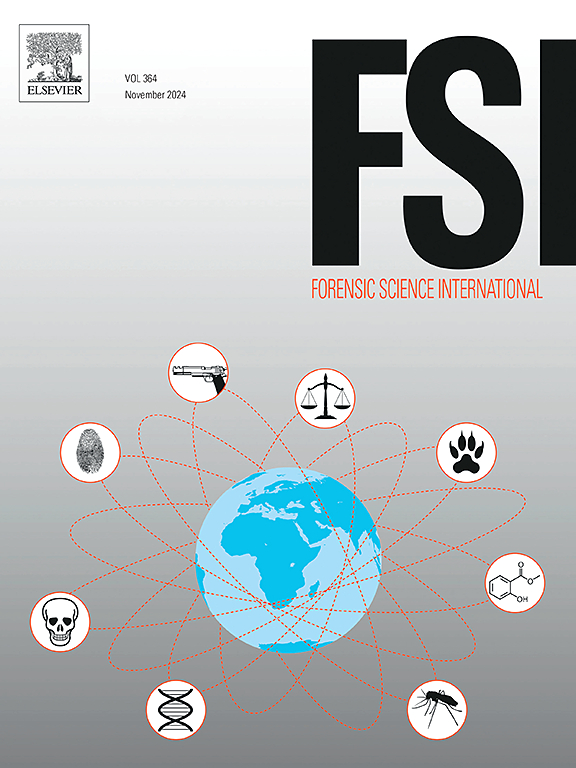采用无DNA提取的室内数字PCR检测方法进行基因掺杂控制
IF 2.2
3区 医学
Q1 MEDICINE, LEGAL
引用次数: 0
摘要
基因兴奋剂意味着使用转基因药物,这对赛马运动的完整性构成了严重威胁,也引发了道德和监管方面的担忧。目前用于检测这类兴奋剂的方法通常需要从血浆中提取DNA,这可能是耗时和劳动密集型的。为了克服这一限制,我们开发了一种直接室数字PCR (cdPCR)方法,可以在不需要DNA纯化的情况下在马血浆中进行转基因检测。以马促红细胞生成素(EPO)转基因为模型,我们通过分析10-1000拷贝/µL的血浆样品来验证该方法。样品用Lysis Buffer S Ver.2进行预处理,并使用针对转基因外显子-外显子连接的水解探针直接用作cdPCR模板。该方法每10µL反应只需要0.55µL的血浆,使我们能够实现一致性检测,低至1000拷贝/µL,具有高重复性和低背景干扰。该方法也被证明能有效地检测纯种马肌注质粒后血浆中的EPO转基因。与传统的基于pcr的方法相比,该方案大大减少了样品处理和处理时间,而灵敏度没有明显下降。我们的研究结果表明,直接cdPCR作为一种实用的工具,在马的运动基因兴奋剂监测的潜在效用。它简化的工作流程和最少的样品要求也表明在法医生物技术方面有更广泛的应用,对法医生物技术来说,快速可靠地检测遗传物质是必不可少的。本文章由计算机程序翻译,如有差异,请以英文原文为准。
Detection using chamber digital PCR with a DNA extraction-free method for gene-doping control
Gene doping, which entails the administration of transgenes, poses a serious threat to the integrity of equine sports and also raises both ethical and regulatory concerns. Current methods used for the detection of such doping often necessitate the extraction of DNA from plasma, which can be time-consuming and labour-intensive. To overcome this limitation, we developed a direct chamber digital PCR (cdPCR) method that enables transgene detection in equine plasma without the need for DNA purification. Using the equine erythropoietin (EPO) transgene as a model, we validated the assay by analysing plasma samples spiked at 10–1000 copies/µL. Samples were pre-treated with Lysis Buffer S Ver.2 and used directly as templates for cdPCR, employing a hydrolysis probe targeting an exon–exon junction of the transgene. This method required only 0.55 µL of plasma per 10 µL reaction and enabled us to achieve consistent detection down to 1000 copies/µL with high reproducibility and low background interference. The assay also proved effective in detecting the EPO transgene in plasma collected from a Thoroughbred horse after intramuscular plasmid administration. Compared with conventional PCR-based methods, this protocol substantially reduces sample handling and processing times, without any appreciable decrement in sensitivity. Our findings indicate the potential utility of direct cdPCR as a practical tool for gene doping surveillance in equine sports. Its simplified workflow and minimal sample requirement also suggest broader applications in forensic biotechnology, for which rapid and reliable detection of genetic material is essential.
求助全文
通过发布文献求助,成功后即可免费获取论文全文。
去求助
来源期刊

Forensic science international
医学-医学:法
CiteScore
5.00
自引率
9.10%
发文量
285
审稿时长
49 days
期刊介绍:
Forensic Science International is the flagship journal in the prestigious Forensic Science International family, publishing the most innovative, cutting-edge, and influential contributions across the forensic sciences. Fields include: forensic pathology and histochemistry, chemistry, biochemistry and toxicology, biology, serology, odontology, psychiatry, anthropology, digital forensics, the physical sciences, firearms, and document examination, as well as investigations of value to public health in its broadest sense, and the important marginal area where science and medicine interact with the law.
The journal publishes:
Case Reports
Commentaries
Letters to the Editor
Original Research Papers (Regular Papers)
Rapid Communications
Review Articles
Technical Notes.
 求助内容:
求助内容: 应助结果提醒方式:
应助结果提醒方式:


